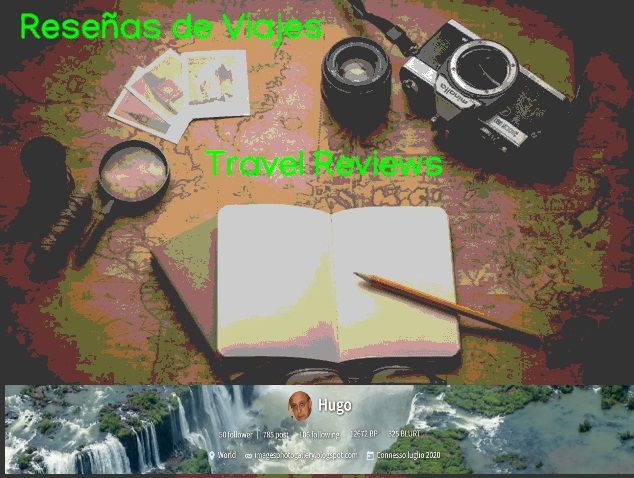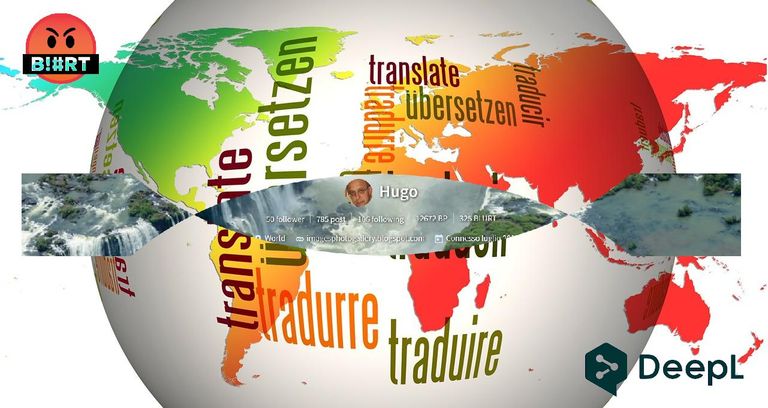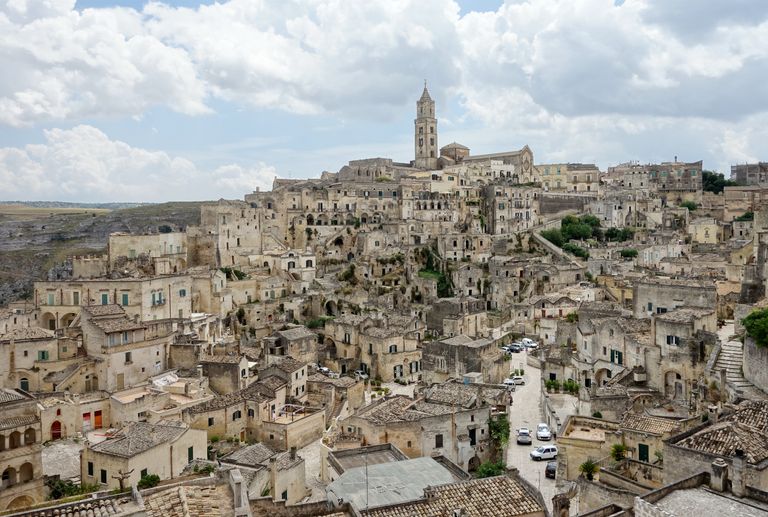
The name "Sassi" identifies the two main districts that make up the historic centre of Matera: the "Civita" and the "Piano". We speak of 'Sassi di Matera' precisely because of this duplicity and not because of the name 'sasso' associated with the premises and dwellings that are built within these districts.
Around the "Civita" develop the Sasso Barisano and the Sasso Caveoso.
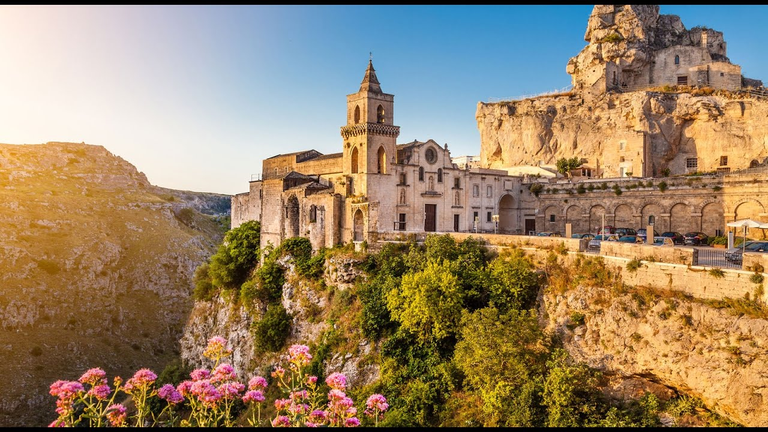
The Sasso Barisano, takes its name precisely from its position. Facing north-west, it owes its name to the city of Bari. Initially it represents the primary part of the Sassi together with the Civita.
The Sasso Caveoso, facing south, owes its name to the city of Montescaglioso, known in the Middle Ages as Mons Caveous. It is characterized by dwellings dug into the tuff, built one on top of the other.
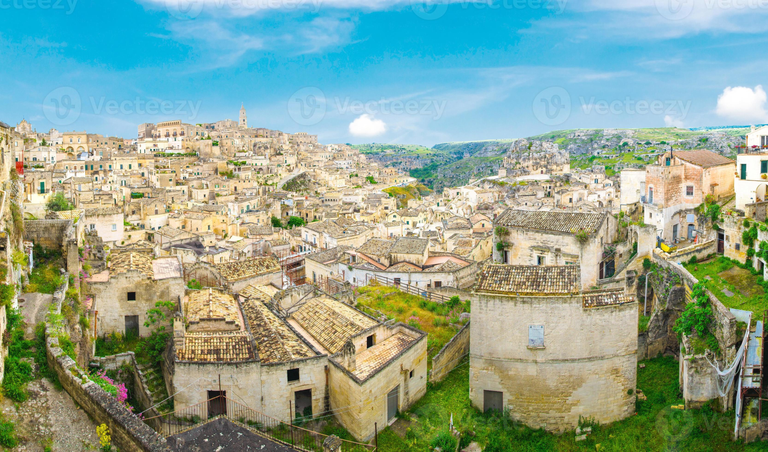
The excavated material was used to build the front part of the house, thus closing the “cave”, hence the name “casa-grotta”. The layout of these houses is reminiscent of a theatre cavea, with the cave houses descending in steps towards the ravine. Originally, the area was secondary to the Civita and the Sasso Barisano, and only began to be populated following a strong immigration of Balkan populations during the 16th century.
Matera is one of the oldest cities in the world, with the first settlements dating from the Paleolithic and Neolithic periods. Many of the houses excavated in the limestone have been inhabited continuously since the Bronze Age. The first definition of the Sasso as an inhabited hamlet dates back to a document from 1204. Various peoples and cultures have succeeded one another over the years.
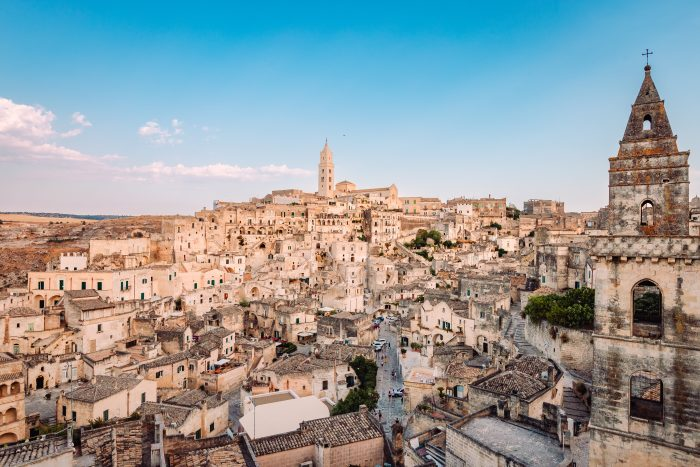
The Sassi are a cultural landscape, to quote the definition with which they were accepted as a World Heritage Site by UNESCO in 1993. They were the first site inscribed in southern Italy. The reason for the inscription was that they represent an extraordinary urban ecosystem, capable of perpetuating rock formations from the distant prehistoric past to modernity.
The Sassi di Matera are an exceptional example of the careful use of natural resources over time: water, soil, energy. In the report of the commission that verified the conformity of the site with UNESCO's evaluation criteria, Matera's candidacy meets the following criteria:

«Criterion III: The Sassi and the Park of the Rock Churches of Matera constitute an exceptional testimony of a vanished civilization. The first inhabitants of the region lived in underground dwellings and worshipped in churches carved into the rock, which were designed in such a way as to serve as an example to future generations on how to use the qualities of the natural environment to harness the resources of the sun, rock and water.
Criterion IV: The Sassi and the Park of the Rock Churches of Matera constitute an exceptional example of an architectural and landscape ensemble that bears witness to significant moments in human history. These range from primitive underground dwellings carved into the stone facades of ravines to sophisticated urban structures built with excavated materials, and from well-preserved natural landscapes with important biological and geological characteristics to urban landscapes with complex structures.
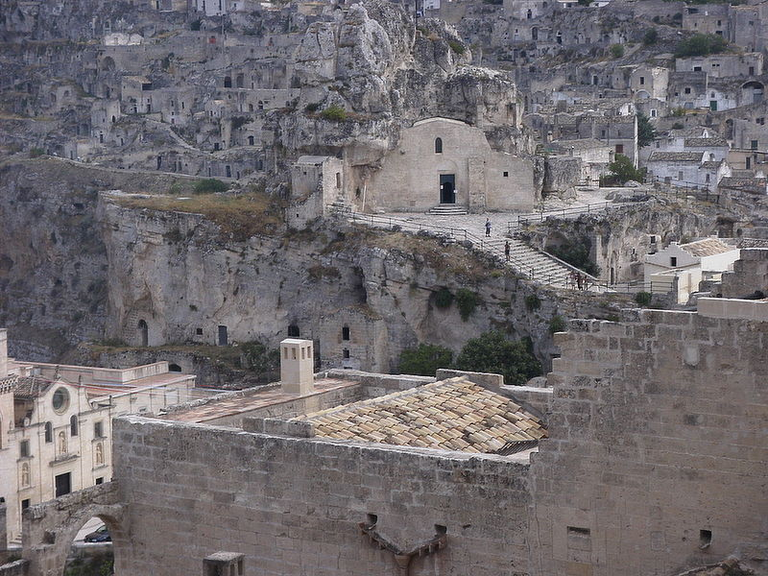
Criterion V: The Sassi and the Park of the Rock Churches of Matera constitute a relevant example of traditional human settlement and land use representative of a culture that, since its origins, has maintained a harmonious relationship with its natural environment. The balance between human intervention and the ecosystem has been maintained for more than nine millennia, during which parts of the rock-cut settlement have gradually adapted to the growing needs of the inhabitants. »
Curiosities of Matera.

The neighbourhoods, made up of a group of houses that face the same open space, often with a well in the centre, were the model of social life, solidarity and cooperation in the Sassi. The communal well where clothes were washed and the oven where bread was kneaded made the neighbourhood the fundamental cell of community organisation. In the houses, light comes from above and the temperature is a constant 15 degrees, with the thermal mass of the sea tuff acting as an air conditioner. If in summer the sun's rays, perpendicular and scorching, stay outside, in winter, obliquely, they slide along the bottom of the caves. This degradation and superposition of houses and huts is only apparently chaotic, because it is then built with so many devices. But the descent into the Sassi is a continuous surprise. Through narrow streets and steps, you reach formidable monastic complexes dug into the rock, Benedictine cenobies and Byzantine laurels, where the monks' cells are crowded around an underground church.

El nombre «Sassi» identifica los dos barrios principales de los que se compone el centro histórico de Matera: la «Civita» y el «Piano». Hablamos de 'Sassi di Matera' precisamente por esta duplicidad y no por el nombre 'sasso' asociado a los locales y viviendas que se levantan dentro de estos barrios.
Alrededor de la «Civita» se desarrollan el Sasso Barisano y el Sasso Caveoso.
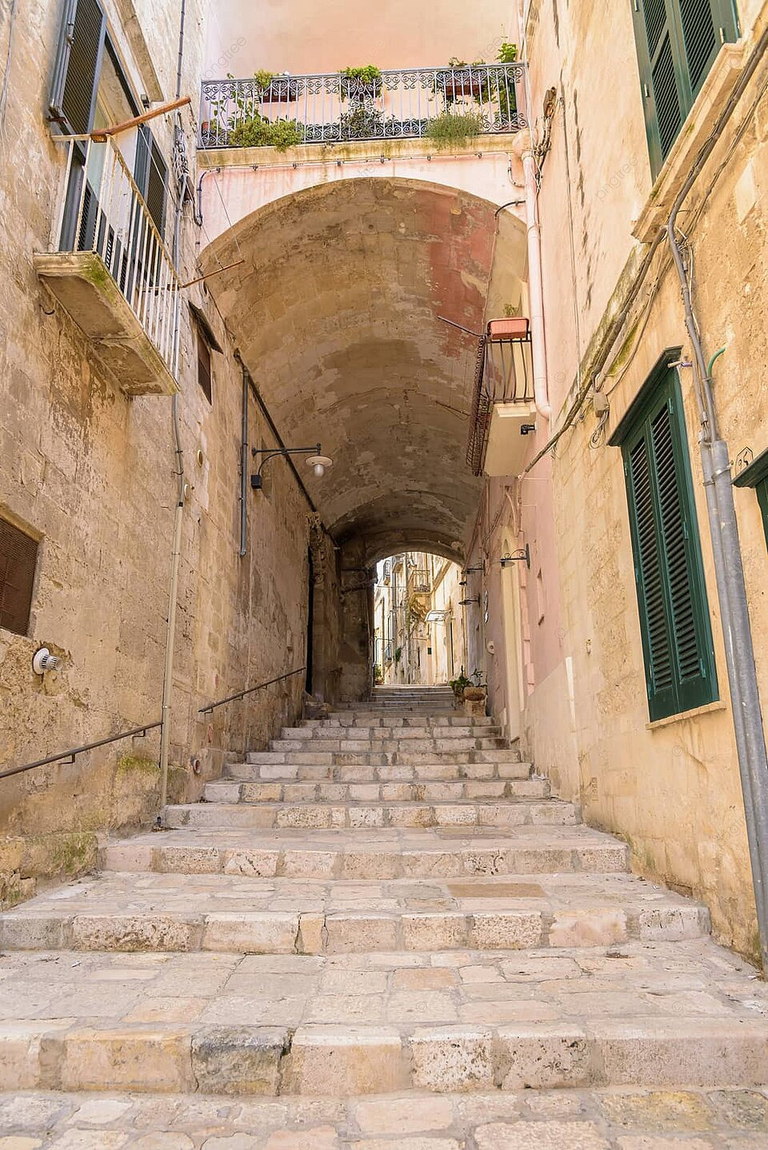
El Sasso Barisano, toma su nombre precisamente por su posición. Al estar orientado hacia el noroeste, debe su nombre a la ciudad de Bari. Inicialmente representa la parte primaria de los Sassi junto con la Civita.
El Sasso Caveoso, orientado al sur, debe su nombre a la ciudad de Montescaglioso, conocida en la Edad Media como Mons Caveous. Se caracteriza por viviendas excavadas en la toba, construidas una sobre otra.
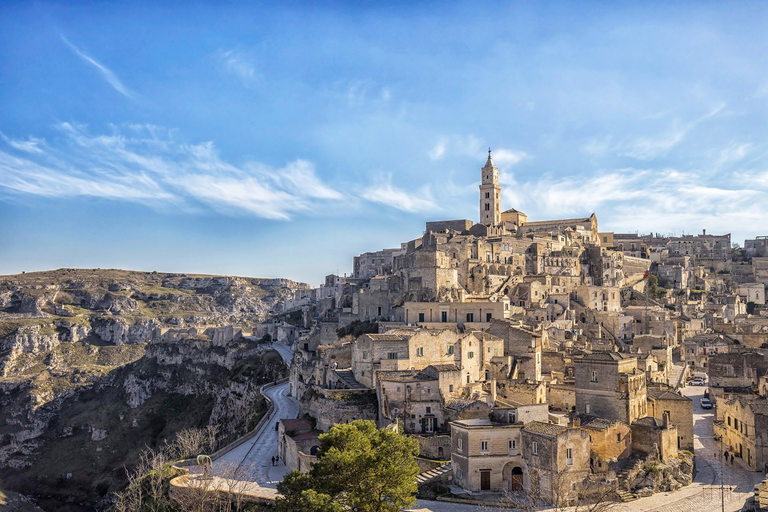
El material excavado se utilizaba para construir la parte delantera de la vivienda, cerrando así la «cueva», de ahí el nombre de «casa-grotta». La disposición de estas viviendas recuerda a la de la cavea de un teatro, con las casas-cueva descendiendo escalonadamente hacia el barranco. Originalmente, la zona era secundaria a la Civita y al Sasso Barisano, y sólo comenzó a poblarse a raíz de una fuerte inmigración de poblaciones balcánicas durante el siglo XVI.
Matera es una de las ciudades más antiguas del mundo, con los primeros asentamientos datados entre el Paleolítico y el Neolítico. Muchas de las casas excavadas en la calcarenita han estado habitadas sin interrupción desde la Edad de Bronce. La primera definición del Sasso como pedanía habitada se remonta a un documento de 1204. Diversos pueblos y culturas se han sucedido a lo largo de los años.
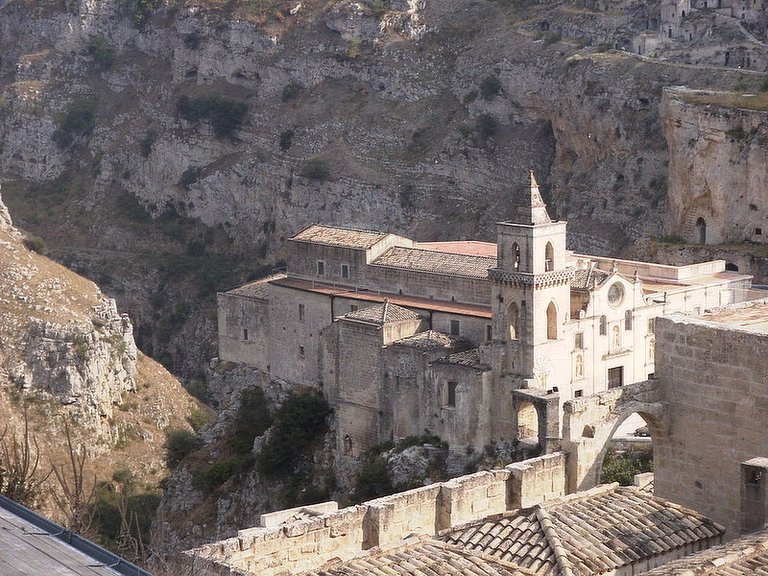
Los Sassi son un paisaje cultural, por citar la definición con la que fueron aceptados como Patrimonio de la Humanidad por la UNESCO en 1993. Fueron el primer sitio inscrito del sur de Italia. La razón de la inscripción fue que representan un ecosistema urbano extraordinario, capaz de perpetuar desde el lejano pasado prehistórico formas rupestres hasta la modernidad. Los Sassi di Matera son un ejemplo excepcional del uso cuidadoso de los recursos de la naturaleza a lo largo del tiempo: agua, suelo, energía. En el informe de la comisión que verificó la conformidad del sitio con los criterios de evaluación de la UNESCO, la candidatura de Matera cumple los siguientes criterios:
«Criterio III: Los Sassi y el Parque de las Iglesias Rupestres de Matera constituyen un testimonio excepcional de una civilización desaparecida. Los primeros habitantes de la región vivían en viviendas subterráneas y rendían culto en iglesias excavadas en la roca, que fueron diseñadas de tal manera que sirvieran de ejemplo a las generaciones futuras sobre cómo utilizar las cualidades del entorno natural para el aprovechamiento de los recursos del sol, la roca y el agua.
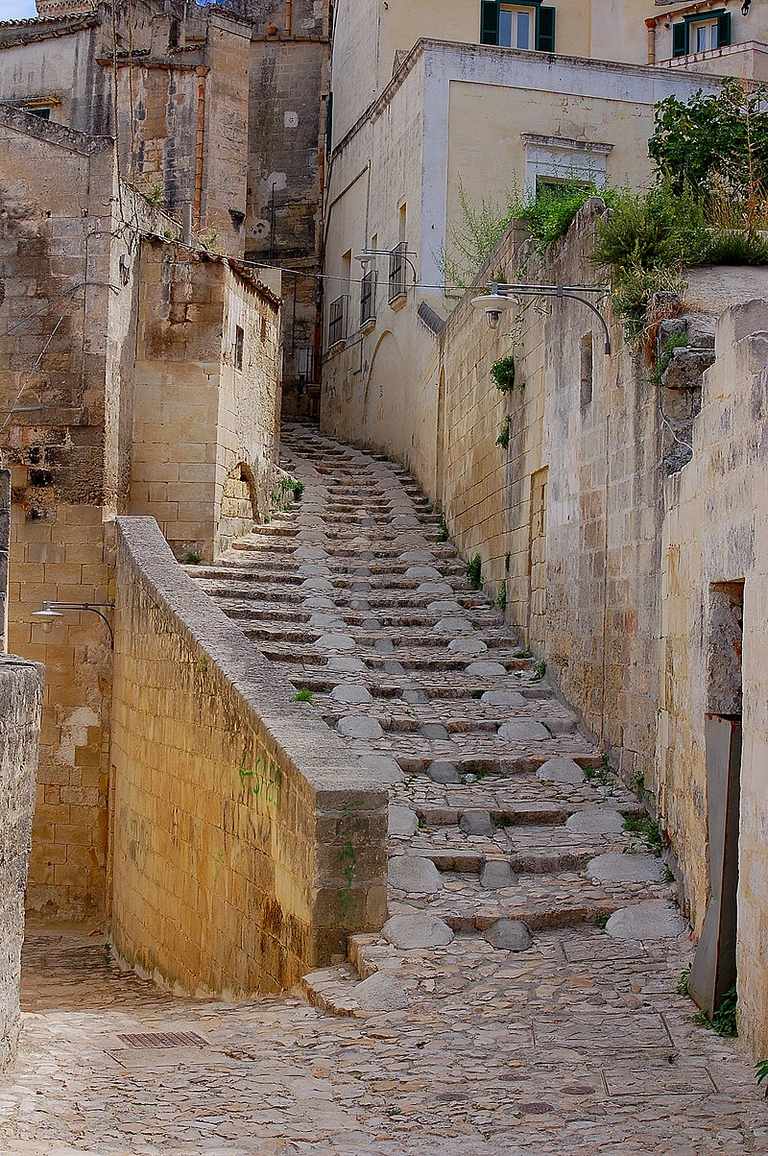
Criterio IV: Los Sassi y el Parque de las Iglesias Rupestres de Matera constituyen un ejemplo excepcional de conjunto arquitectónico y paisajístico que testimonia momentos significativos de la historia de la humanidad. Estos van desde primitivas viviendas subterráneas excavadas en las fachadas de piedra de los barrancos hasta sofisticadas estructuras urbanas construidas con los materiales excavados, y desde paisajes naturales bien conservados con importantes características biológicas y geológicas hasta paisajes urbanos con estructuras complejas.
Criterio V: Los Sassi y el Parque de las Iglesias Rupestres de Matera constituyen un ejemplo relevante de asentamiento humano tradicional y de uso del territorio representativo de una cultura que, desde sus orígenes, ha mantenido una relación armoniosa con su entorno natural. El equilibrio entre la intervención humana y el ecosistema muestra continuidad durante más de nueve milenios, durante los cuales partes del asentamiento excavado en la roca se fueron adaptando gradualmente en relación con las crecientes necesidades de los habitantes. »
Curiosidades de Matera.
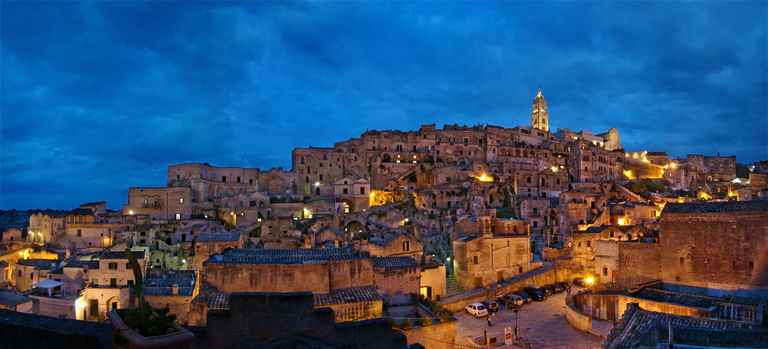
Los barrios, formados por un conjunto de viviendas que dan a un mismo espacio abierto, a menudo con un pozo en el centro, eran el modelo de vida social, solidaridad y cooperación en los Sassi. El pozo comunal donde se lavaba la ropa y el horno donde se amasaba el pan hacían del barrio la célula fundamental de la organización comunitaria. En las casas, la luz viene de arriba y la temperatura es de 15 grados constantes, con la masa térmica de la toba marina actuando como climatizador. Si en verano los rayos del sol, perpendiculares y abrasadores, se quedan fuera, en invierno, oblicuos, se deslizan por el fondo de las cuevas. Esta degradación y superposición de casas y cabañas, es sólo aparentemente caótica, porque luego se construye con muchos artilugios. Pero el descenso a los Sassi es una sorpresa continua. Entre callejuelas y escalones, se llega a formidables complejos monásticos excavados en la roca, cenobios benedictinos y laureles bizantinos, en los que las celdas de los monjes se apiñan en torno a una iglesia subterránea.
Source images / Fuente imágenes: Sassi di Matera.
